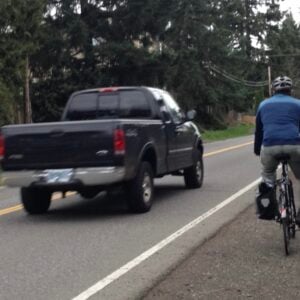“There ought to be some higher level of consequence when you use a deadly weapon to kill someone, even if you didn’t do it on purpose.”
— Ray Thomas, lawyer at Swanson Thomas Coon & Newton
There’s a gap in Oregon law that has outraged citizens and hamstrung prosecutors for many years. It’s a gap that makes it all too common for someone to receive a mere traffic citation when their actions while operating a vehicle lead directly to a serious injury or fatality.
This maddening situation first made major headlines here on BikePortland following our tragic October of 2007 when Tracey Sparling and Brett Jarolimek where killed in traffic collisions. In both cases the person behind the wheel of a large truck turned across a bicycle lane that was already occupied and two people died as a result. Despite those actions, the District Attorney declined to pursue criminal charges in either case.
The problem here isn’t with the DA’s office. The DA is constrained by Oregon law which currently has a yawning gap between the culpability threshold of a traffic ticket and a more serious criminal charge.
“There ought to be some higher level of consequence when you use a deadly weapon to kill someone, even if you didn’t do it on purpose.” That’s how noted lawyer Ray Thomas described the problem to us when we published a story about this gap in 2010.
Advertisement
And we were all unfortunately reminded once again about this problem less than a month ago when the DA declined to pursue criminal charges in the Alistair Corkett collision.
The first step toward change is learning; so at Wonk Night this coming Monday October 26th we’ll educate ourselves this issue and begin the process of bridging this frustrating gap.
To help unravel this complicated issue, we’ll be joined by three of Multnomah County’s top prosecutors: District Attorney Rod Underhill, Chief Deputy District Attorney Chuck Sparks, and Deputy District Attorney Glen Banfield. I’ve worked with DA Sparks on several cases over the years and I think you’ll find his approach, candor, and depth of knowledge very helpful. As an elected official, DA Underhill is the person who could take the lead on addressing this issue system. DA Banfield was the County’s lead on the Corkett case.
Also joining us will be advocates who helped craft and then pass Oregon’s landmark Vulnerable Roadway Users law in 2007.
As always at Wonk Night we’ll provide the snacks and drinks. All you need to bring is an open mind and a willingness to share what’s in it. If you’re new to Wonk Night, check recaps from past events here.
Please consider joining us!
Wonk Night: Closing the Negligence Gap
Monday October 26th at 6:00 – 9:00 pm
Lancaster Engineering (321 SW 4th Ave, 4th Floor)
RSVP on Facebook
— Jonathan Maus
(503) 706-8804
jonathan@bikeportland.org
@BikePortland







Thanks for reading.
BikePortland has served this community with independent community journalism since 2005. We rely on subscriptions from readers like you to survive. Your financial support is vital in keeping this valuable resource alive and well.
Please subscribe today to strengthen and expand our work.
Such an interesting topic. Sorry to be out of town and miss it. Take lots’o notes for me.
There was an incident in Texas over the weekend where a motorcyclist was making a pass across a double yellow line and the car swerved and hit the motorcycle. The motorcycle crashed and injuries to the motorcycle passenger are severe. The lack of accountability for drivers is so ingrained into driver mentality that they are not even aware that their vigilante “justice” (for a traffic infraction) is assault with a deadly weapon. The driver is claiming he was stung by a wasp, but dash cam video and subsequent audio (may) refute that claim.
Is intent to cause harm necessary to punish drivers who harm vulnerable road users? If so, how can intent be proven if drivers are sealed in their motorized “cans”? If intent to cause harm is irrelevant to the crime, as it is to the victim, how can the can of worms opened by the paradigm shift in accountability be managed? This is a big question. As with most difficult issues that our society faces, I expect leaders to punt despite the increasingly vocal outcries for safe streets.
http://abcnews.go.com/US/texas-driver-swerved-motorcyclist-blames-insect-bite/story?id=34591022
The video appears to show a case where the car driver intentionally hit another vehicle. I suspect such cases are fairly rare except in road rage incidents. I’m betting the car driver gets convicted of a criminal charge.
As far as the “gap” goes, you cannot charge a person with a crime for making a simple mistake. People make mistakes – that’s part of life. And mistakes that kill people rarely go unpunished – the car driver usually pays thru the nose in a lawsuit. So, they are ruined financially unless they are wealthy. Seems like pretty harsh punishment to me. AND in many cycling deaths, the cyclist is partly at fault for one reason or another, even if the main fault lies with the car driver. Fact is, cyclists are hard to see, so as long as they are in car traffic they will continue to be hit by cars and wishing it could be different will not make it different.
yes, we need harsher penalties… so long as they’re not mandatory… we want more options, not less leeway…
It is sad that many drivers seem to feel no sense of real responsibility for avoiding running over people, except that they don’t want to damage their cars or “feel bad”; not all drivers, but many. Even as conscientious as I try to be when driving, I almost can’t help but feel that if I slip up and do some real damage, it will be nothing more than an insurance hassle. Along with that creepy feeling is the subliminal thought that everybody else is looking out for me and my car because they know the same thing: if they get themselves run over by being careless around me, it’ll be their own fault; I’ll have an insurance hassle and they’ll have two broken legs and a TBI.
I think the beginning of changing the way things are is to require a certificate from an accredited driving school before issuing any licenses. I also don’t think it would be a bad idea to require sitting through the same traffic safety course as citation recipients can opt into to have their offenses expunged. Driver testing should be much more rigorous—for first-timers AND renewals. And we should figure out a way to add more accountability for “accident” results into the law. The VRU amendments go a short way toward this level of accountability, but they are so rarely applied, and really amount to a slap on the wrist.
The problem comes in figuring out what to compare unintentional “traffic violence” to. Is it the same as being careless with a gun? Is it more like a sports injury, a “bad hit” in football or a line drive to the face in baseball? Is it comparable to a workplace (e.g., construction site or factory) mishap? None of these really seem to fit if we continue these analogies to the roads themselves: are streets really a shooting range? Are they a sports field while the sidewalks are “the stands”? Is the street like a construction site where hardhats are required and fences are put up to keep out everybody who isn’t a construction worker?
However we want to conceive of streets and drivers and cars and other modes, we have to be careful that we don’t just end up with stiff penalties for offenses that are nearly impossible to commit (or end up causing more victim-blaming in an attempt to avoid such stiff penalties).
Excellent thoughts, El B. It strikes me that rear-end collisions provide at least a partial analogy for thinking about the problem. Granted, the arbiter is the insurer, not the courts, but there are some similarities.
With very few exceptions (say, when your car is stationary and the driver in front of you backs into you), the rear-end collision is always the fault of the rear-ender, not the rear-endee. It’s accepted that the one thing you have control over in almost all driving situations is the amount of space between your car and the car ahead of you. Nobody questions that if you’re tailgating or not paying attention, and you smash into the next car, you’re 100% at fault. Whine and moan all you want, it’s your fault and everybody knows it.
I don’t see why we couldn’t identify a few reasonable exceptions and proceed along the same line with car-on-bike or car-on-pedestrian collisions. No, not every exception can be proven. Yes, unverifiable exceptions will go the way of the driver. But it would be a starting point.
No 2 traffic accidents are the same. Each has to have an investigation.
I’ve been trying to figure out my feelings on this issue lately and just wanted to say thanks for offering up some analogies I hadn’t yet considered.
Damn and blast I wanted to be at this one, and I’m going to be out of town. Let’s make something happen, and get some laws rewritten.
This will be an uphill battle as legislators will trot out stories of how grandmas and teens will be put in jail for “accidents”. Lars Larson will say ” bikes chose to be on the road with cars”. OPB will say “Oregon will be the first in the nation to have such a far reaching law” in the lovely Brit accent of Christian Fodenvantzel…
The reality is…fines +community service need to increase at a huge rate. At least assign a misdemeanor to crashes that dismember limbs or kill. Earmark real money so odot can run real education campaigns across all media.
But remember, there is an implied immunity while behind the wheel. People like that.
When thinking about the “gap” think about what you as a cyclist can do to make riding safer. Trying to get car drivers, politicians, ODOT, PBOT, police, etc, to make cycling safer is fine, but in the past has had limited success. In the mean time, what can YOU do?
https://www.youtube.com/watch?v=tf1VA5jqmRo
For the amount of hell I hear for not wearing a helmet, and rolling through red lights you would think I was out there killing people. Someone in a car actually does and they only face the same ticket I get on my bike for disregarding a signal?
Bicycling is viewed as voluntary, driving a pickup truck with a hood that is taller than most pedestrian’s heads is totally normal. The bike lane scares me at times, I like to be in the same part of the road as the other things drivers pay attention to and are willing to brake for.